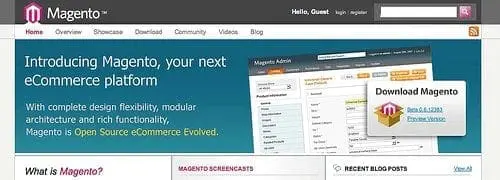In order to install the latest version of Magento, you will first need to visit the Magento website and check that the server you plan on using meets all of the minimum installation requirements:
https://magento.com/resources/system-requirements
To find this information on the Magento website, hover over the Resources tab on the navigation bar and then click on System Requirements. In order for Magento to install properly, your server needs to meet all of the listed requirements.
The next step involves downloading Magento. Hover over the Products tab and click on Open Source / CE. You will then be taken to the Magento Community Edition page where you can click on ‘View Available Downloads.’ You will then be asked if you want to create an account. Whilst registering isn’t compulsory, it will benefit you, as you will able to post questions on the support forum and report bugs.
Once you have done this, you will be able to select the version of Magento you want to install. Choose the latest Full Release version and click the ‘download’ button. A window will then pop up asking if you wanted to save the file so click OK.
When the file has finished downloading, find its location and unzip it using an archive programme. You will then be able to upload the full Magento file to your server, using a programme like FileZilla.
After you have double clicked the file you want to upload, you will be required to enter a host name, username and password. From there you will be able to choose the folder you want to upload Magento to.
The next step involves dragging and dropping the file into your directory. Once it has finished uploading, go to your web browser and enter the address of your Magento folder.
When you open up the Magento Installation Wizard you will first need to read through and accept the terms and conditions. You will then be able to select the default time zone and currency you wish to use.
On the next page you will find that information such as your host, database and username have been entered automatically. Check that they are correct before proceeding.
Before you can continue with the installation, you will need to create a database on your server. The first step requires you to enter your database name, username and password. You will then be able to scroll down and find more options where you can select a base URL admin path and secure URLs. Scroll right to the bottom and you will find the Session Storage Options where you can set session data to save to a specific file location or database.
Continuing with the installation will require you to ensure all folders are writeable.
At this point in the process you will need to create an admin account. Here you will be required to input your personal information, login information and encryption key.
You will then be able to complete the installation and begin using the Magento platform. Whilst you will be given the option to go to the frontend of backend, it is recommended that you start at the backend so you can begin setting up your store.
How to install Magento theme
If you are looking to make the installation process as easy and straightforward possible, it’s best to get your Magento themes from the Magento Connect store. The Magento Connect store has a great selection of premium and free themes that you can install easily without needing any technical knowledge.
The first step is to browse the themes on the Magento Connect store and choose the one you want to install. Open it in a new tab and you will see there is a button under the theme titled ‘Get Extension Key’ click on this button and agree to the extension license agreement (have a read of it first).
Once you have done this, you will then be presented with the Magento theme’s extension key. Press ctrl + c to copy the key, as you will need to paste it into your store’s Magento connect tab.
In order to install the theme, login to your Magento store’s admin panel and go to System > Magento Connect > Magento Connect Manager. You will then be required to login again. Once you have done this, you will be given the opportunity to paste the theme’s extension key into the box on screen.
Soon after you have done this, you should see the ‘Theme successfully installed’ message. You can then go to System > Configuration > Design > Themes to give the theme a default name (remember to press save config after).
After you have done this you will be able to visit your Magento store’s homepage and check you like the look of your new theme. We told you it was very straightforward!
Image Credits: mj0310 and sprovoast04

A selection of our older posts, written by various members of the team between 2015 to 2021.










0 Comments